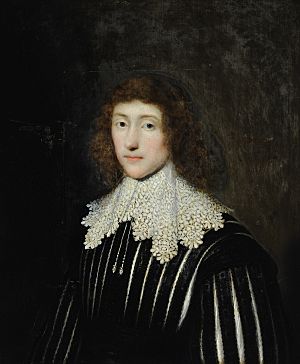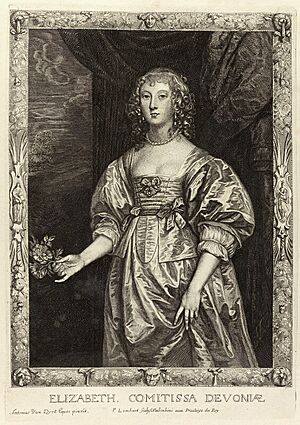William Cavendish, 3rd Earl of Devonshire facts for kids
Quick facts for kids
The Earl of Devonshire
|
|
|---|---|

1631 portrait painting of William Cavendish by Cornelis Janssens van Ceulen
|
|
| Born | 10 October 1617 |
| Died | 23 November 1684 |
| Spouse(s) | Elizabeth Cecil |
| Children | William Cavendish, 1st Duke of Devonshire Charles Cavendish Lady Anne Cavendish |
| Parent(s) | William Cavendish, 2nd Earl of Devonshire Christian Cavendish, Countess of Devonshire |
William Cavendish, 3rd Earl of Devonshire (born around 10 October 1617, died 23 November 1684) was an important English nobleman and politician. He was known for strongly supporting the King during a time of great change in England. He was also a Knight of the Bath (KB) and a Fellow of the Royal Society (FRS), which means he was part of a special group of scientists.
Contents
William Cavendish's Life Story
Early Life and Education
William Cavendish was the oldest son of William Cavendish, 2nd Earl of Devonshire and his wife, Christian Cavendish, Countess of Devonshire. His mother made sure he received a good education. One of his teachers was Thomas Hobbes, a famous philosopher who had also taught William's father.
Hobbes even dedicated his translation of an ancient Greek book, Thucydides, to William. From 1634 to 1637, William traveled around other countries with Hobbes, learning a lot about the world.
Supporting the King
When he was young, in 1625, William was made a Knight of the Bath at the coronation of King Charles I. This was a special honor.
From 1638 to 1642, he served as the Lord Lieutenant of Derbyshire. This role was like being the King's main representative in that county. William was a strong supporter of King Charles I. When troubles started between the King and Parliament, William stood with the King.
He was with King Charles I in York in 1642. Because he supported the King and did not attend Parliament, he was accused of serious crimes. He refused to appear before the House of Lords and was removed from Parliament. He was even ordered to be sent to the Tower of London.
To avoid this, William left England. His family's lands and money were taken by the Parliament.
Life After the War
William Cavendish returned to England in 1645. He made peace with Parliament and was forgiven in 1646. He had to pay a large fine of £5,000. After this, he lived quietly with his mother at their home in Latimer, Buckinghamshire. King Charles I even stayed a night with them in 1645.
When the King was restored to power in 1660, William got all his titles and lands back. He was again made Lord Lieutenant of Derbyshire. He also became a steward for important areas like Tutbury and the High Peak.
William was very interested in arts and sciences. He was friends with John Evelyn, another famous writer and gardener. In 1663, William became one of the first members of the Royal Society, a group dedicated to improving knowledge through science. He mostly lived in the countryside until he passed away on 23 November 1684, at his home in Roehampton, Surrey. He was buried in Edensor. His wife, Elizabeth, died five years later and was buried in Westminster Abbey.
Family Life
William Cavendish married Elizabeth Cecil on 4 March 1639. Elizabeth was the second daughter of William Cecil, 2nd Earl of Salisbury.
Together, William and Elizabeth had three children:
- William Cavendish, 1st Duke of Devonshire (1640–1707): He later became the 1st Duke of Devonshire.
- Charles Cavendish: He passed away young in 1671 and never married.
- Lady Anne Cavendish (around 1650–1703): She married Charles, Lord Rich, and later John Cecil, 5th Earl of Exeter. She had children.


